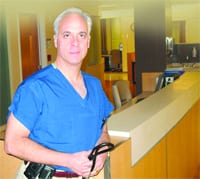Primary-care Shortage is Changing the Way Services Are Delivered
The shortage of primary-care physicians, besides creating longer wait times for both new and existing patients, is also changing how care is being delivered.
National pharmacy chains are seeking bigger roles in patient care, like managing chronic diseases, and they’re developing partnerships with medical groups large and small across the country.
Non-physician health professionals are also pressing for more opportunities. Nurse practitioners, for example, encouraged by a 2010 Institute of Medicine report, are engaged in advocacy and legislative efforts to establish independent practice, unburdened by physician supervision. Chapter 224 of Massachusetts General Laws, passed last year, included a new definition of primary care and expanded authority for nurse practitioners (NPs) to sign documents once limited to physicians. This has given some NPs the impetus to set up independent practice.
What effects will these efforts have on primary care? Let’s take a closer look.
Retail clinics: How often and for what purposes patients will visit retail clinics remain open questions, as these clinics are just now expanding their services from basic offerings to more complex endeavors such as lab services and managing chronic diseases. Unlike many other states, Massachusetts health officials have established a long list of regulations that these limited service clinics must follow. However, Chapter 224 also requires the state Department of Public Health to promote these clinics to the full extent of the scope of practice of NPs (who generally run these operations), but not to classify the clinics as primary-care providers.
Research shows that patients like the convenience of retail clinics, particularly when they have difficulty getting to their primary-care provider. Given the limited resources and no on-site physicians, most patients may not regard them, at least for now, as a place for primary care. As they add more sites, services, alliances, and advertising, however, they are likely to play a bigger role in health care — a prediction already being made by many healthcare analysts.
Nurse practitioners: NPs play a vital role in health care. They always have, and they will play an even larger role as the team approach to care becomes more prevalent with medical homes and accountable-care organizations.
The idea, however, that independent practice by NPs can fill the physician gap falls short. For one, a nursing shortage exists alongside the physician shortage, and nurses, like physicians, are an aging part of the healthcare workforce, with more than half of all nurses approaching retirement. The difficulty in recruiting nursing-school faculty to teach a new generation adds to the problem.
Independent practice by NPs isn’t likely to increase the number of primary-care providers; at best, it might redistribute some to underserved areas. Most now work in urban areas, as physicians do, and most hospitals will not allow NPs on staff without physician supervision.
Further, with an emphasis on cost containment, replacing high-salaried providers (physicians) with lower ones (NPs) with less training will likely not result in savings. We have seen that less-experienced providers tend to order more tests and procedures, raising costs. Cost control will result best from the team approach of coordinating care and avoiding unnecessary referrals, testing, and procedures.
Finally, as independent or solo practice by physicians is becoming less and less viable with the growth of medical homes and accountable-care organizations, the same is likely to happen with nurse practitioners.
While retail clinics and independent practices may have their place, continuity and coordination of care is much preferred over fragmented care from multiple providers. I believe the basis of good healthcare remains within the physician-patient relationship, supported by nurse practitioners, physician assistants, and other allied health professionals in a team approach. Patients will benefit most from this kind of approach. –
Dr. Ronald Dunlap, president of the Mass. Medical Society, first published this article in the MMS blog; blog.massmed.org



Comments are closed.